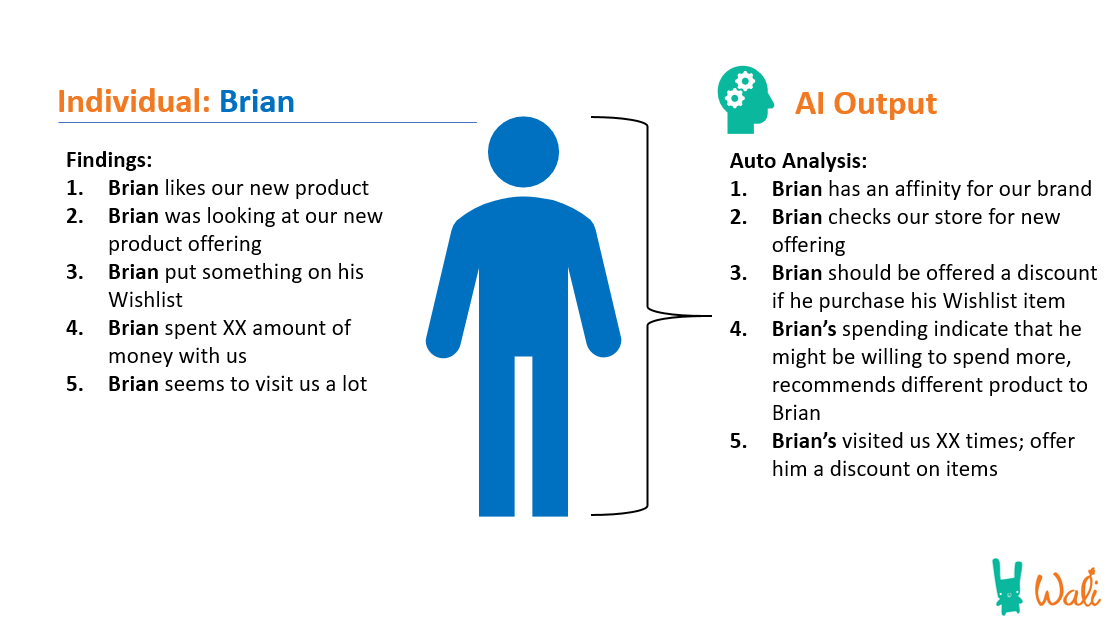Why businesses even the small businesses should care about audience Segmentation
Audience segmentation is a well-known principle of marketing for those in the field. For those who are not in the field, in short, it is dividing up your current audience/customer base into different groups.
For example, if you run a small retail store, your customer segmentation could be:

Customer segmentation is used in many marketing goals; like awareness, conversion, etc. For this post’s purpose, we’re going to focus on segmentation used to bring customers back into the stores, i.e., customer lifetime value and loyalty. After all, Wali is all about helping you extend your customer loyalty.
What it comes down is to know your audience. Back in traditional marketing days that graphics above is what marketers would think about when segmenting their audiences. You’d have an entire population of your customer base, and then you’d segment them into different groups based on overall personality, trait, buying purchase, etc.
This was the traditional mode of thinking. It demands a lot of assumptions about the type of customers that your business would market to. For example, you might guess incorrectly that one customer group in your segmentation prefers value over pricing, but it could be proven incorrect because you never know how they really feel. Of course, you could do research and hedge those assumptions but when you’re a small/medium sized business, where’s the money to do that?
A different, more technological direction
Research takes time and money…but in the new age of technology, there is no reason why we shouldn’t leverage technology to self-learn our audiences. In traditional mode, we make the assumption, and our markets fall into little boxes that we have segmented, mainly we are assuming that they will behave one way based on past data.
But, with current social trends, where everyone has a “unique story” (again thanks to Social Media) behaviors are becoming more erratic and harder to predict, Why? Because of Everyone…Everyone thinks that they are “special” that they follow their own social code, that their story is unique and their behaviors are now not just influenced by those around them, but potentially people half way across the world.
This is a problem for marketers because we still operate as if people are in boxes. Oh, you’re a hipster you must behave this way…Oh, you’re a jock you must behave another way. In our opinion, this kind of assumption in marketing is outdated and should change.
Marketing needs to focus on the individuals, not the group
With technology at its height, we can apply automation to change the paradigm of how marketing is done. With current social trends, businesses like yours should focus our messaging on the individual, make them feel like they are unique and unprecedented by any of your competitors. What would set you apart from your competitor? Your ability to know your customer intimately…without getting too weird. 😉
“This is a problem for marketers because we still operate as if people are in boxes. Oh, you’re a hipster you must behave this way…Oh, you’re a jock you must behave another way. In our opinion, this kind of assumption in marketing is outdated and should change.”
Machine learning can now track behaviors and shoot out outputs that allow us to create a profile for not a group…but for an individual. Individualization is the name of the game, and the one that does it well will own their market. Why? The social trend, wouldn’t you like to feel special everytime you go shop?
We drew out an example of what we were thinking of down below:

With technology, your segmentation can be derived not from a subset of a group but to an individual. Theoretically, you’d be able to make recommendations based on Brian the individual rather than what sub-set of what Brian belonged to. This means that he will feel like he is getting some focused attention from your business because you are consistently offering, and feeding him suggestion based on what he likes and what he wants. Also theoretically he will return to your business more because you are consistently providing what he might like specifically rather than a broad stroke messaging.
Some example of what it could look like messaging-wise:
Traditional:
“Come get 20% off on our newest pair of men’s Jeans from designer Kevin Fancypants”*
*(The above statement is made with a subset group in mind; male, is influenced by brand name, values new and improve products)
Automation:
“Brian, we think you might like this new pair of Jeans from designer Kevin Fancypants, he seems like a designer you might like. Come in, and we’ll give you 20% on your purchase!”**
**(The above statement is made with Brian in mind; male, have an affinity to branding, prefers newer product…all of which derived from past data)
What’s the difference?
The difference is one focused on multiple Brians while the automation system focused on just Brian. On some level, there is a brand likeness increase if you give more attention to the individual customer rather than just messaging in a broad stroke. And that was the whole point of segmentation.
We segment individuals in our customer pool so that we know who we are talking to. So when we go do promotion to bring back customers, we can cater to specific audiences. But with technology, we can provide to the individuals rather than the subset groups. That’s the kind of innovation that marketers have been missing thus far, but give it a couple of years (or maybe a little bit more) we’re all heading there.
Thanks for reading another Idea Post!

